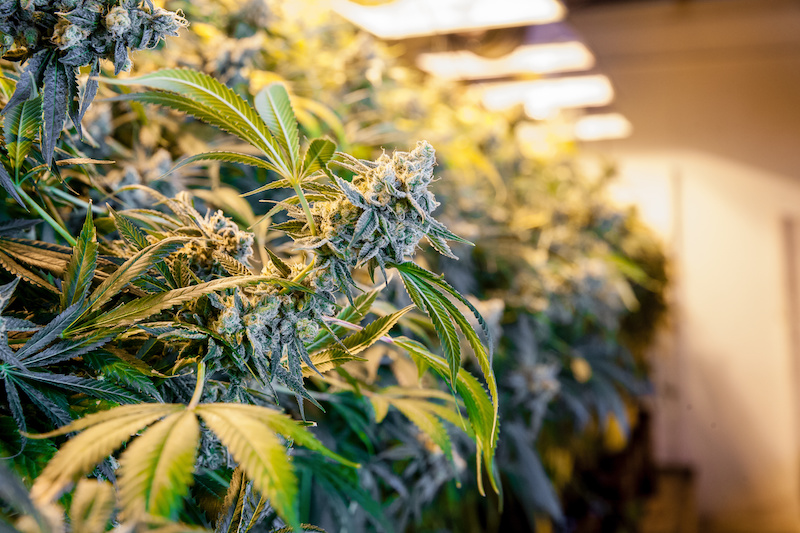Features
Cannabis investors can push for climate friendly weed
Published on November 12, 2021 by Corinne Doan

The cannabis industry is not immune to climate change.
With the COP 26 UN Climate Change Conference in Glasgow ending Friday, climate issues are top of mind for many—including investors.
Socially responsible investors will put their money where they feel it will make the most impact.
That’s where Environmental Social Governance (ESG) comes into play.
Corinne Doan takes a deep dive into ESG and why cannabis companies need to take notice.
Power to sustainable investors
ESG stands for Environmental Social Governance. It’s the new business buzz term and tool for assessing companies’ holistic sustainability. ESG is getting noticed because it impacts the financial bottom line and that is of interest to investors. To better understand let’s take a brief look at ESG history.
The revolutionary idea behind sustainable business practices first gained traction with the concept of Corporate Social Responsibility (CSR). In 1971 The American Committee for Economic Development suggested there should be a contract between society and business. That was a shift from the traditionally conservative mindset that believed a companies’ only purpose was to make shareholders money.
In 1994 business writer John Elkington introduced the triple bottom line theory which suggests there should be an equal weighting between people, planet, and profit. The theory was incorporated in Shell’s first sustainability report in 1997.
The notion of sustainability and corporate social responsibility caught investors’ attention during the turn of the century. Investors started seeking investments that considered social and environmental consequences. The movement began a trend toward Socially Responsible Investments (SRI). Investors increasingly scrutinized what to buy, and in hand, companies were increasingly being held to higher standards. The movement forced companies to rethink the traditional definition of a high-performance.
In her book Value Shift: why companies must merge social and financial imperatives to achieve superior performance, Lynn Sharp Paine writes: “Matters today such as honest accounting, treating employees with dignity, disclosing product risks, or being a good corporate citizen are not merely means to outstanding performance- they are increasingly part of its very definition.” In contrast, she adds, “a high-performance company that competes unfairly, mistreats employees, or neglects its civic role is becoming a contradiction in terms.”
Today, there are several mutual funds and exchange traded funds which focus exclusively on CSR.

A 2005 United Nations Global Contact study called ‘Who Cares to Win’ coined the phrase Environmental Social Governance or ‘ESG’. The study concluded better investment leads to more sustainable societies. The difference with ESG and the other acronyms is measurement. Although there is a current demand for sustainability, CSR, and SRI there is no one single standard for measurement.
In 2015 the United Nations developed The Sustainable Development Goals (SDG). It is a blueprint for 17 interlinked global goals designed to achieve ‘a better and more sustainable future for all.’ The goals identify specific targets that can be measured and are intended to be achieved by 2030. It was ratified by 193 countries including Canada.
The Paris Agreement is a legally binding international treaty on climate change that entered into force Nov. 4, 2016. Its goal is to limit global warming. Not only did Canada commit to the Paris Agreement, but the country has also committed to exceeding the international goals. With that, federal mandates encourage companies to adopt sustainable practices and reporting which are measurable.
• RELATED: More stories by Corinne Doan
Recently ESG was a featured topic for a presentation by the Canadian Securities Exchange (CSE) and MNP—one of Canada’s leading accounting firms outside the ‘big 4’.
Richard Carleton CEO of CSE explained there is research dating back several years suggesting investors look for investments that make them feel better and provide return. However, there is significant debate on how these companies should be measured and scored. In Canada the challenge is usually within the oil and gas and mining exploration sectors because they don’t score very well on the ‘E’ of ESG. More, what are the social issues from operating on lands with First Nations? Also, mining and engineering tend to be male oriented. Further, Carleton noted, discount brokers have been opening new accounts at record rates over the past 18 months. Most of those investors are from the younger generation who want to match their objectives with social, environmental, and sustainable investment objectives. This has put pressure on the Canadian financial markets to respond appropriately.
Mike Falkner VP Listings and Regulation at CSE added there is an existing lack of measurable standard. The regulatory frames for the CSE and IIROC focus on existing policies and best practices which include review for balanced disclosure. Soon, the CSE will be publishing comprehensive policy amendments that will include a broad requirement with specific objectives for any issuer that claims to be in compliance with non-exchange standards. The new policy will mandate to disclose how compliance has been established and who was responsible for establishing those requirements. The CSE is not setting a standard but consistent with a focus on disclosure, the CSE will require investors have the information and details to determine if their investment standards or objectives are met. That is consistent with the goal to make companies accountable to measurable standards.
Defining Environmental Social Governance or ‘ESG’
Edward Olson MNP Leader of Environmental Social Governance defines ESG as a “cluster of non-financial factors that have a financial impact.” With his colleague Mary Larson MNP Partner and National Leader Organizational Renewal Practice they explain the three pillars. The following information emanates from the MNP presentation.
Environmental
The first pillar looks at “how an organization is exposed and manages risk and opportunity.” The fundamental criteria are:
- Energy efficiency
- Carbon footprint
- Water usage
- Waste management
- Packaging
- Biodiversity management
Social
The social pillar “considers an organizations values and relationships.” The fundamental criteria are
- Employee attraction and retention
- Diversity and inclusion
- Pay equity
- Customer data privacy
- Social acceptability of projects/ business
- Organizational culture
Governance
The Governance pillar focus is on “structure and diversity.” The fundamental criteria are
- Climate change
- Cybersecurity
- Corruption and bribery
- Responsible taxes
- Compensation
- Reliable financial disclosure
Drivers
Today, there are a cluster of drivers influencing the increasing trend of ESG including governments, regulators, employees, investors, financial institutions, security commissions, and customers. They are all seeking financial alignment with company values, shareholder values and social values. The key term being ‘values.’ The World Business Council for Sustainable Development in January 2020 said, “In today’s complex and uncertain world, focusing on near term shareholder value alone is no longer enough to ensure long term business success. Sustained value creation requires companies to manage business performance to ensure sustainability matters that affect business value are addressed. At present, sustainable value is being destroyed by governance systems that fail to address wider sustainability matters affecting the company.”
There has been an established link between ESG and financial performance. Results from a Harvard business review study over 21 years with 2000 US companies found companies with improved material ESG issues significantly outperformed their competitors.
Many large Canadian companies like CN or BMO are filing sustainability reports. ESG has not only become good for business, but also it has become necessary.

ESG and the Cannabis Industry
The MNP team did a deep dive into ESG impact on the cannabis industry. They explained the overreaching trends of the cannabis sector to be:
- Stigma– Given the nature of the industry’s unique history with legalization and the fact cannabis is still illegal in most countries, industry players constantly need to overcome public and policymaker perceptions and need to abide by strict regulations.
- Desire to displace the illegal market– The illicit market fails to implement environmentally sustainable methods of production and operate with a lack of education and ethics. The introduction of regulatory market provides the opportunity to displace the illegal market and implement ESG practices into operations.
- Implementing ESG practices attracts capital, satisfies consumer and employee expectations, and reduces industry stigma– Investors are more likely to provide capital to companies which integrate ESG in their operations and other stakeholders are more likely to use products and work for and / or accept companies who employ ESG practices.
Cannabis specific business impacts and considerations for the ESG pillars
Environment
1. Soil degradation
Challenge
- Some agricultural practices can be destructive causing soil erosion, nutrient loss, reduction in organic carbon stored in the soil, increased acidity, susceptible to pests and disease, which leads to considering pesticides, or synthetic fertilizer which can further destroy soil health.
Mitigate
- Adopt soil regeneration practices and land use planning, identify the short, medium, and long-term impacts of planting decisions that can reduce the risk of soil degradation. Continuous soil testing can help make informed decisions on how to optimize soil health. Create, manage a strategy to mitigate soil degradation.
2. Water Contamination
Challenge
- Outdoor farming practices rely on water supply from artificial irrigation. This causes run off which can bring negative impacts with pesticides, heavy metal, excess nutrients, or glutens.
- Indoor practices can put pressure on municipal water systems. Discharge of excess nutrients, industrial cleaners which increase stresses on wastewater treatment facilities, leads to increased carbon emissions as the water is treated.
Mitigate
- Understanding water consumption and wastewater and what the impact is on the life cycle of the water resource.
- Prevent water contamination and reduce water use with minimal amount of required water. Use automated irrigation, capture excess water for reuse that can reduce waste, and understand there is no one standard practice. Consider the difference in geo locations to meet needs. Continuous water treatment and quality testing enables informed decisions.
3. Waste Production
Challenge
- Primary source is due to single use consumer packaging of products. Regulatory requirements imposed on packaging types makes it difficult to reduce waste because it is mandated. Look for innovation with approach to reducing waste while still remaining compliant with laws and regulations.
Mitigate
- Producers and retailers can work together. Have a ‘take back’ packaging option. Consider what is the waste created and where it goes. Can it be biomass?
4. High Energy Use
Challenge
- Indoor growing is an energy intensive crop. It is necessary to have reliable access to sources of energy and perhaps many different energy generated sources. Many different generation sources have ‘scope 2’ greenhouse gas implications through indirect emissions that need to be considered in the carbon footprint.
Mitigate
- Reduce energy use and alternate sources. Consider LED lighting and havoc systems. Optimize space and scheduling with the use of high energy equipment around peak demand which can reduce energy usage and costs by taking advantage of lower energy rates. Also consider alternative energy sources such as wind, solar or biomass.
5. Reduced Air Quality
Challenge
- For indoor or outdoor operations consider the volatile organic compounds ‘VOC’ amended from cannabis plants as they grow as well as during extractions through the solvents used during the process. VOCs contribute to the formation to ground level ozone which also has a direct threat to public health and environment so process to track and control and mitigate is critical.
Mitigate
- Protect air quality. Tech innovations systems need to be balanced off the energy that is being used. Create a comprehensive solution with a consolidated outcome.

Social
Canadian cannabis industry is unique in society and has a complex history.
1. Criminalization
Challenge
- Racial communities have been disproportionately criminalized. What are the racial minority reactions to legalization? And what is the rest of society’s’ reaction to them?
- There has been an increase in cannabis related offences since legislation.
- Difficult to employ qualified experienced people because of the criminal record check.
Mitigate
- Some jurisdictions equity models have been utilized allowing the industry access to victims from ‘the war on drugs.’ If charged with a conviction or live in a geographic area with a disproportionate high level of cannabis arrests, there are programs to ensure those individuals are helped and given opportunities to work.
- Ensure leadership teams within cannabis companies are diverse and represent minority groups. Companies can be seen as being responsive to societal issues.
2. Social Stigma
Challenge
- Notion society has about stereo types of users that they are lazy, dangerous, less intelligent.
Mitigate
- Reduce social stigma. Join the effort to produce evidence to the benefits of cannabis.
- Position cannabis as a socially acceptable product with advertising. Place store locations in busy streets next to other attractive retailers.
- Engaging with the community that are producing product in turn builds positive relationships.
3. Safety concerns and usage
Challenge
- Looking for demonstrated proof from the health care sector and research.
- Impairment for driving safely or operating equipment.
- Impairment of coordination, reaction time, decision making ability, ability to judge distance.
- Judgement issues are higher amongst younger people.
- Longer term health effects such as inability to concentrate, ability to think among issues.
Mitigate
- Address safety concerns of usage. Research and share information about the positive effects of cannabis use and safe deployment to mitigate risk.
- Ensure quality of products are rigorous as possible.
- Corporate health and safety programs for employees and other users.
- Marketing campaigns, product development, packaging, any communications to consumer need to be thought through and highly responsible. Target audience is appropriate and particularly not target youth.
4. Shifting user demographics
Challenge
- User patterns shift for age levels, income levels, and geography.
- Reasons for use are fluctuating focus on medical applications and help applications, to benefit the sector.
- Risk to attract the sector that shouldn’t be using cannabis, specifically those under 18
Mitigate
- Identify user demographics. Invest in research to identify consumer trends e.g., aging population baby boomers. And promote cannabis use in a responsible way.
Governance
Weak governance can inhibit industry player success
1. Lack of Governance Processes
Challenge
- Because the industry is new, there is a lack of known governance, and that creates a lack of tolerance for investors.
Mitigate
- Leadership Knowledge and Experience. Boards need to identify skills and experience for the management teams, which are required for success and growth of the current state and trajectory.
2. Lack of leadership diversity
Challenge
- Companies are often led by founders with limited experience for navigating growth and propelling startups to larger companies, including seeking investors and being publicly listed.
- Diversity equity and inclusion are social and governance issues because companies need to strategize its current work force. What is the makeup from the board down to the entire organization? Is there representation of the communities you work in as well as the customers you serve? Consider a strategy to be diverse inclusive of all types.
Mitigate
- Diversity of leadership. Company founders may need to be replaced by leaders with more experience. What is good for an entrepreneur is not always in line with growing and maturing company.
- Need necessary for skills of accounting, information technology and HR to manage company risk.
- Do you have a formal approach to address diversity hiring?
3. Compliance challenges and risk
Challenge
- Good corporate governance is also good compliance. Combination of high growth and high regulations in the industry creates a need for manufacturers, distributors, retailers to know the high level of regulations. Be aware of the changes and the implications of the changes. Are you responding in time? Noncompliance can shut a business down. How good is the governance for overseeing ensuring good compliance practices? Also, consider governance of theft, product tampering, and resale on black market.
Mitigate
- Managing compliance. The board should have experience in risk management and compliance to ensure the right questions are asked of management.
- Is the right evidence received to back up opinions?
- Larger companies should have internal audit departments for compliance.
- Boards should implement an employee group solely focused on compliance, testing compliance, and reporting to the board.
4. The fight for capital disclosure
Challenge
- Companies seeking to be publicly listed need to keep in mind the regulators requirements for sufficient internal controls over financial reporting. Are the CEO and CFO certified for financial disclosures ensuring controls are appropriately designed and operating effectively?
- Takes capital to operate and grow a business. Attracting investors is challenging due to a large volume of new entrants to the market. There is investor uncertainty given the risk of investing in less mature companies.
- Need skills to communicate clearly with investors and create required disclosures and a skilled team to back up and ensure all is working as designed to communicate to investors and other stake holders.
Mitigate
- Addressing stakeholders and disclosure. Boards should implement disclosure practices and guidelines. Ensure investors are provided with relevant and timely and accurate information. Boards can only do this if management have the right process in place.
Cannabis Stocks and ESG
It is evident ESG, and sustainability impacts the bottom line and investors take notice. A number of cannabis companies have responded to the trend. Cannabis companies that have released ESG sustainability reports are:
• Green Thumb Industries (GTII:CSE)
• Hexo (HEXO:TSX) – September 16, 2021 Hexo announced it achieved carbon neutrality.
• Khiron Life Sciences (KHRN:TSXV)
• Rubicon Organics (ROMJ:TSXV)
• Scotts Miracle-Gro (SMG:NYSE)
MNP Recommended Next Steps
- Evaluate where your company sits in sustainability adoption.
- Get help (3rd party) because change is coming.’

Concluding Vision: A world where long-term interests outweigh short-term gains
In a world filled with materialism, capitalism, wealth, power, corruption, and greed, it would seem to take a worldwide catastrophic event to cause a global radical change in investment mindset. Planet-wide climate change, a pandemic, inflation, civil unrest, scandalous leadership, and overall corporate irresponsibility—in essence everything short of a zombie apocalypse- have provoked a global response. The effect of the ‘perfect economic storm’ is a global movement towards transparency, co-operation, and partnership that enhance ESG investments.
Paine writes, “Investors seem increasingly aware of the causal chains through which misconduct can lead to lost confidence, lost sales, hiring difficulties, legal problems, and credit downgrades that undermine a company’s market value. More investors today are attracted to companies that create long-term shareholder value through attention to economic, environmental, and social developments, and—target companies that are setting best-practice standards while also maintaining superior financial performance.”
The choices to operate an ESG mandate have given businesses a competitive edge in the investment industry. Initiatives with measurable goals, like those set at this year’s Glasgow COP26 climate conference, also align with a new standard for investment principles. Shareholders are shifting away from short-term interests and embracing more long-term plans and the climate for ESG is undoubtedly starting to flourish.
Glossary of Acronyms and Terms
Big 4 — A term commonly used to describe the 4 largest accounting firms in North America. These being Ernst & Young, Deloitte, PWC, and KPMG
CSE — Canadian Securities Exchange is an SRO
CSR — Corporate Social Responsibility incorporates trends towards sustainability in the business world.
ESG — Environment Social Governance
IIROC — Investment Industry Regulatory Organization of Canada is an SRO
MNP — Meyers Norris Penny one of Canada’s leading accounting firms outside the big 4. Prior to legalization in 2018, it was the only significant size firm willing to audit cannabis companies. Although its headquarters are in Calgary, AB, the firm was founded in Brandon, MB. – only the best city to grow up in Canada!
SDG — The Sustainable Development Goals is a blueprint of 17 interlinked global goals designed to achieve ‘a better and more sustainable future for all.’ The goals identify specific targets that can be measured and are intended to be achieved by 2030.
SRI — Socially Responsible Investment(s) considers social and environmental consequences of investments.
SRO — Self Regulatory Organization
Triple bottom line — People Planet Profit
VOC — volatile organic compounds
About the author
Corinne Doan is Canada’s first published author with a book regarding Canadian cannabis investments titled Canadian Cannabis Stocks Simplified: A How-To Guide for the Budding Investor. She was a licensed investment advisor with a focus on venture capital markets and held investment industry (IIROC) relevant licenses with the Canadian Securities Course (CSC), options and branch managers. Also, Cori has an MBA with specialty disciplines in public relations and communications. Any data or Information that is not directly cited in this report is believed to come from reliable sources.
Leave a comment on our Facebook page.
© Copyright 2021 Okanagan Z. | About the oz.
Report a Typo or Inaccuracy
We strive to avoid typos and inaccuracies. However, on occasion we make mistakes. We value your contributions and help in correcting them.